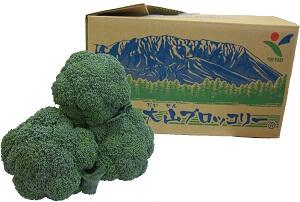Daisen Broccoli
| Registration Number | 70 |
|---|---|
| Name of the GI | Daisen Broccoli |
| Class | Vegetables/ Cereal grains/Pulses |
| Date of Protection | 2018/12/27 |
| Producing Area |
Tottori Prefecture
Saihaku County (Daisen, Hiezu, Nambu and Houki Towns), Hino County (Nichinan, Hino and Kofu Towns) and Yonago City |
| Applicant - Name and Address | Tottori Seibu Agricultural Cooperative 1-5-16 Higashi-fukubara, Yonago City, Tottori Prefecture |
| Brand-site |
Producing Area
Daisen Broccoli is a flavorful broccoli that is highly recognized in the markets as a result of thorough quality control and continued efforts to ensure a stable supply.
The producing area of Daisen Broccoli is the country's leading broccoli producer, holding approximately 20% of the Nagoya market, in which Daisen Broccoli earns its highest sales. Its average price in the market is approximately 10% higher than that of broccoli grown in other areas.
For the production of Daisen Broccoli, producers consider forecast weather of the year and growing conditions of each farm, and then choose the most suitable cultivar from varieties specified by the producers' group on the basis of field trials conducted in the area.
Methods of cultivation include the following, although the schedule may be adjusted according to the weather conditions of the year: early summer harvesting, in which the crop is seeded from mid-January to mid-February, transplanted from mid-March to mid-April, and harvested from early April to early July; and autumn-winter harvesting, in which the crop is seeded from early July to late August, transplanted from early August to early October, and harvested from late September to late April.
When transplanting the seedlings, the sparse planting (1) pattern is adopted with planting density of approximately 4,000 plants per 1,000 m2.
Mature plants are harvested between 10 pm and 9 am when the temperature is low (or between 1 pm and 10 am during the season in which the average temperature remains at approximately 10 °C or below). Plants may also be harvested at other times if the use of refrigeration facilities allows the temperature of the products to be maintained as low as those harvested during the above hours.
During harvesting, the plants are covered with a thermal insulation sheet, and further sprayed with water when dry, in order to lower the temperature of the products.
Harvested broccoli plants are inspected for any damage, such as from disease and pests. Thereafter, they are put in fresh keeping bags set in cardboard boxes for shipment, while broccoli plants temperature is still low.
Boxed broccoli plants undergo vacuum precooling at approximately 5 °C for 20 minutes, and they are shipped by means of refrigerated transportation at approximately 5 °C during the period from around March to early December, or at approximately 2 °C during the period from around mid-December to late February.
The producing area of Daisen Broccoli, the foot of Mount Daisen, is characterized by sandy loam consisting of well-drained and highly organic andosol. The mean annual temperature in the area is approximately 15 °C, and the mean temperature difference between day and night approximately 8 °C, which makes the area well suited for growing broccoli.
The production area extends from coastal flatland to semi-cold upland (at an altitude of 600 m). This allows the producers to grow their plants mainly in the flatland during the cold months and in the semi-cold upland during the warm months, thereby achieving the continuous shipping of high-quality broccoli.
As a pioneer in broccoli production in western Japan, producers in the area started growing broccoli in 1969 in rice paddies converted to dry fields in Nakayama, Daisen Town (former Nakayama Town).
The area has been highly recognized as one of the largest broccoli producers in the country, with a total cropping acreage of 376 ha and an annual production of 4,120 tons as of 2015.
- Sparse planting: To plant the seedlings thinly, spaced well apart.


